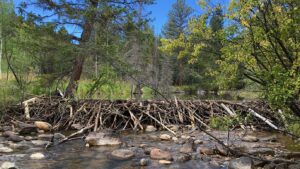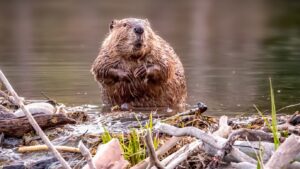Lucy Sherriff is a smart reporter that used to be a free lance writer in the US that developed a passing interest in beavers. She used to complain that the best parts of her articles in the Smithsonian or the Discovery magazine were taken out. Now she works for the BBC and you can bet how happy beavers are about that.
The US is bringing back nature’s best firefighters: beavers
For decades, beavers were considered pests – trapped and shot on sight. Now the attitude towards nature’s best engineers is changing, and farmers are working to bring them back.
 Beavers are vital to ecosystems, as their dam building habits spread water through parched landscapes. This can not only help to regulate the flow of water, it provides another important service – keeping fires under control. Beavers are nature’s firefighters.
Beavers are vital to ecosystems, as their dam building habits spread water through parched landscapes. This can not only help to regulate the flow of water, it provides another important service – keeping fires under control. Beavers are nature’s firefighters.
Despite their monumental impact on the environment, beavers were almost wiped out in the US during the fur-trapping trade. And the land, like Wilde’s, has suffered greatly due to the decimation of beaver populations. Attitudes that beavers are a nuisance, because of the damage they can cause to human-built structures – such as flooding culverts, the drain pipes that channel water through roadways and other structures, and felling trees – also prevailed long after beaver fur hats went out of fashion. For decades, the animals were trapped, shot, poisoned, and their dams dynamited – all to eradicate the keystone species from their native lands. Landowners simply didn’t want them messing with the ecosystem. Since the battle against beavers began, numbers have shrunk from millions to thousands.
Did you get a second cup of coffee and settle in? Because this is going to be a great read with some of our best beaver friends. I can just feel it.
Now, the tide is beginning to shift, and beavers are making a comeback.
“From the 1950s until this year, beavers have been listed as predators in Oregon,” explains Jeff Baldwin, a geography professor at California’s Sonoma University who has published numerous studies on the advantages of recolonising beavers in the American West. “And in Oregon, if an animal is a predator you can kill it.”
A “beaver believer” bill was passed in Oregon in 2023, changing the animals’ status to furbearers, meaning they cannot be killed without a permit. The bill highlighted beavers’ role as a keystone species “that serves as nature’s engineer…[Their] habitat has the ability to provide refugia, stimulate the recovery of other species, and foster resilience on landscapes impacted by climate change”. But, the bill wasn’t popular with everyone – especially farmers.
“[The bill] creates an unnecessary and complicated system of beaver management for private agricultural landowners,” says Lauren Poor, vice president of legal affairs for the Oregon Farm Bureau, an agricultural advocacy organisation. “Our opposition to this needlessly complicated piece of legislation is no reflection on the value beavers play in the ecosystem or the benefits they have on repairing floodplains, however, the great value of beavers to our environment is best suited for public lands, not privately managed agricultural lands.”
That beaver bill sounds interesting, I’m thinking that Jeff is the right guy to talk about this stuff.
Oregon’s legislative change is indicative of what is unfolding across the American West. For many years, bureaucracy has been a huge hurdle for pro-beaver groups hoping to bring back the animals. But the years of “beaver believer” PR work is paying off.
“There’s been a rapid turnaround and increase in the understanding of the importance of beavers in our ecosystems,” says Peggy Darr, who runs the non-profit Defenders of Wildlife’s Southwest programme, and has been working on beaver reintroductions in New Mexico for the past six years. Darr is talking about the attitude of government agencies, but also says the public’s perception has shifted too. “There are a lot of misconceptions about beavers, but that’s starting to change.” Misconceptions include that beavers eat any kind of tree, when they are actually very picky, and that they compete with farmers for water, when beavers can in fact bring water back into the ecosystem.
“We’ve found that just through opening channels of communication, understanding the rural farming community’s concerns, and showing how we can address the negative things that come with beavers really helps,” says Darr.
Something as simple as installing pond levellers – dubbed “beaver deceivers” – can prevent beaver ponds from flooding houses or other structures, Darr explains. The leveller is a large pipe with a cage around one end that is inserted into a beaver dam. The cage means the beavers can’t plug the pipe up, and so the beaver pond water can’t rise above whatever level the pipe is inserted in at. “A lot of times we saw they came back the next day and started patching all around the pipe,” says Darr. “But no matter how much they patch on the pipe or try to build the dam taller, the water level will stay at the level of the pipe.”
I love any article that mentions flow devices! Lucy mentioned recently that this article was coming out. What a great lead in for 2024!
 In northern New Mexico, Darr has seen farmers “drastically” change their perception of beavers. “They were pretty hesitant, but they saw first-hand how the beavers provided sustained, reliable water sources throughout the year, even during the hot dry summer we had. To see it is to believe it. We just have to show people what beavers can do for other wildlife, and humans.”
In northern New Mexico, Darr has seen farmers “drastically” change their perception of beavers. “They were pretty hesitant, but they saw first-hand how the beavers provided sustained, reliable water sources throughout the year, even during the hot dry summer we had. To see it is to believe it. We just have to show people what beavers can do for other wildlife, and humans.”
In December 2022, beavers were released into the wild in California for the first time in almost 75 years.
California’s beaver reintroduction programme is a promising a step in the right direction, though, says Kate Lundquist, director of the Occidental Arts and Ecology Center, the organisation which led the pilot programme. “We’re very hopeful that this is the beginning of a new era of proactive beaver conservation,” she says.
Nature’s engineers
For centuries, Native American tribes understood the importance of having beavers on the land. Not only do the wetland beavers provide a habitat for other animals, such as otters, turtles, and fish, they are also extremely efficient at protecting landscape from wildfires. Beavers create deep ponds by building dams, but they also dig long, thin canals that gradually spread water throughout landscapes. The slow flow of water allows the ground time to absorb it, which both encourages the growth of plants and flourishing of wildlife, but also acts as a firebreak as the ground is wet. In fact beavers are so great at shaping ecosystems, they’re often referred to as nature’s engineers – as well as firefighters.
Ecohydrologist Emily Fairfax studies how water interacts with its surrounding ecosystem. Fairfax examined years of aerial photographs from Western states where major wildfires and droughts had occurred. Amid the black, charred landscape following a destructive wildfire, Fairfax could see vibrant patches of green. Her study found that beaver-dammed riparian corridors are “relatively unaffected” by wildfire compared to other areas without beavers, and the animals play a “significant role” in fire resistance.
“Beavers are a major solution to helping us adapt to future climate change effects,” Darr says. “They’re amazing creatures that can help us a lot if we just learn to live with them.”
Go read the whole rest of the article. I promise you you’ll want to share it with friends and enemies alike.





































